Ditty Maria Dominic participated in the consultation workshop on ‘Digital Innovation and Transformation in Food-Water-Land Systems in India’ organised by One CGIAR during 8-9 November 2022, and she shares her experiences here.
CONTEXT
Under its new research for development (R4D) initiative on digital innovation and transformation, the Consultative Group on International Agriculture Research (CGIAR), organised a two-day workshop on 8 and 9 November 2022, at Bhubaneswar, Odisha, India.
The workshop was aimed to better understand the actor landscape of the digital ecosystem in food-water-land systems. This includes: the availability, accessibility, gender responsiveness and effectiveness of services; the challenges and opportunities in promoting an inclusive, gender-intentional and beneficial digital ecosystem; and the data management challenges associated with data security and governance. Essential stakeholders encompassing representatives from government, research, private, producer and Non-Governmental Organizations having expertise and experience in digital innovations participated in the workshop.
SESSIONS
Introduction to the One CGIAR Initiative on Digital Innovations
In this introductory session, Dr Jawoo Koo (IFPRI), Dr Hom Gartaula (CIMMYT), and Dr Andrea Gardeazabal Monsalve (CIMMYT) – all from One CGIAR – set the tone for the workshop with an overview of the One CGIAR Digital Innovations Initiative. They briefly described the potential of the digital innovations to transform the agri-food systems in low- and middle-income countries (LMICs), the prevalence or persistence of the digital divide within geographies, communities and within households, and the challenges that need to be overcome for bridging the digital divide.
The five major work packages (WPs) of the digital innovations initiative include: an enabling environment, digital inclusion, systems modelling, real-time monitoring, and platforms and services. These were all discussed. Dr Jawoo Koo stressed on the importance of co-ordinated activities across these five WPs to deliver a suite of outputs through three pathways (policy, innovation, and capacity building) to support three levels (decision-makers, service providers, and users).
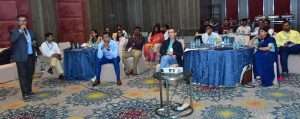 Dr. Hom Gartaula (CIMMYT) delivering the introductory session on One CGIAR digital initiatives
Dr. Hom Gartaula (CIMMYT) delivering the introductory session on One CGIAR digital initiatives
The expected outcomes from the One CGIAR digital innovations initiative were also discussed as follows:
- Informed policymakers and investors formulate enabling policies for locally-led digital ecosystems, develop digital strategies, establish public-private partnerships, and attract strategic investments toward bridging the digital divide;
- Improved digital services and information systems provide more timely, accurate, and actionable information that helps agri-food system actors manage climate and food security risks; and
- Empowered women and youth use digital technologies, leading to improved livelihoods and job opportunities.
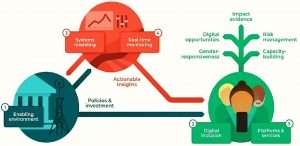 The Five Work Packages of the One CGIAR- Digital Initiative
The Five Work Packages of the One CGIAR- Digital Initiative
Then Dr Gartaula elaborated on the topic of gender digital divide in India. He briefly explained the barriers to women’s participation in digitized agri-food value chains, such as, social norms, lack of access and control over resources, and lack of digital inclusion. He also described the immediate and long-term opportunities for inclusive digital innovations, by forging partnership with non-traditional actors (women, youth and marginal communities).
For all the subsequent sessions participants were divided into groups, for more discussions on these topics where the participants could share their insights, opinions and expertise.
Mapping the Digital Ecosystems
The major aspects discussed during the breakout sessions included the existing digital infrastructure in agri-food systems; the key actors involved, the types of services provided by these actors; and mode of service delivery. The digital ecosystem is huge and there is a need to investigate micro ecosystems so as to facilitate mapping. The existing infrastructure includes mobile-based apps, Web-based Apps, Internet of Things (IoTs), MIS, GIS modelling, Geo tagging, etc., to name a few. Though digital infrastructure exists, it is inadequate, especially in the rural areas due to poor connectivity (bandwidth) and low accessibility to mobile devices among and within rural households. There are multiple actors, providing different digital innovative services, using multiple service delivery methods. The major actors include government institutions (Central, State and Regional), private sector stakeholders, NGOs, research organizations, farmers, entrepreneurs, Farmer Producer Organizations (FPOs), Self-Help Groups (SHGs), financial institutions, knowledge intermediaries, etc. The major services being provided include crop advisory and information services, supply chain management services, market information, market linkage, facilitation services, financial inclusion, weather advisory, technical services (software development, web management), etc. The main mode of service delivery is through mobile phones (WhatsApp, SMS, IVR), Internet of Things, etc., mostly facilitated by human intermediaries such as extension agents, staff of Common Service centres (CSCs), staff/members of the Agricultural Production Committees/Clusters (APCs), SHGs, FPOs, Village Champions and Village Youth.
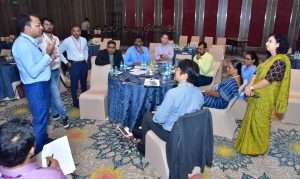 Discussion on mapping digital ecosystem
Discussion on mapping digital ecosystem
Laying the Foundation for Inclusive Digital Innovations
Opportunities and challenges in promoting inclusive, gender-intentional and beneficial digital ecosystem were discussed during this session. One of the major challenges cited by the participants is lack of availability of sex disaggregated data, even with respect to ownership and usage of digital tools (such as mobile phones), while designing digital solutions. Some actors opined that gender is not well-defined even from the government perspective, for instance in the census data itself gender is not given due weightage. Another crucial challenge identified is the lack of capacity to assess the needs of women and other marginalized and vulnerable groups. Digital services are designed and delivered mostly in a supply driven (PUSH) and top-down approach. The contents pushed through these services are mostly not need based and are not context specific. Gender and social inclusion is an afterthought once the digital service has been designed and deployed. Need assessment, along with community engagement, during the process of designing digital innovations is an important aspect to be considered before deploying digital services. Technical service providers view gender inclusion as a lesser challenge in the project design phase itself even if the gender component is included, but most of the institutes do not investigate this aspect in the project design phase.
Some participants opined that currently accessibility is not a problem but the hitch is lack of need-based digital services. Affordability, information gap, and lack of incentives are some of the other challenges identified by the participants. Some of the participants felt that these services would be more used if they were bundled with enhanced market access, and also enabled sale of surplus produce, supported farmers in obtaining better rates for their produce, etc. They also felt that there is a huge opportunity for digital service penetration through mobilisation of women into groups. Digital innovations have wide scope in facilitating access to credit and empowering women and other marginalised groups, financially as well as socially. Other major opportunities for making digital innovations inclusive and gender intentional are bundling up services, using a combination of technologies, delivering services with human facilitation and integrating the gender component into the government’s monitoring and evaluation system. This will enhance collection of gender disaggregated data and tap into the potential of rural youth in digital service delivery by augmenting their capacity as they are more trusted and have more access to digital technologies in rural areas.
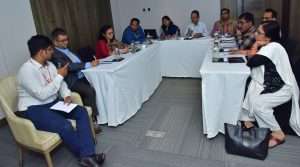 Discussion on laying foundation for inclusive digital innovations
Discussion on laying foundation for inclusive digital innovations
Data, Evidence and Responsible Digital Innovations
In this session participants discussed what kinds of data are available and collected, how it is collected, is it gender disaggregated, what are the data gaps, data security and management challenges; and what are the efforts that can improve and address data challenges. A wide variety of data is collected according to the purpose, such as primary, secondary, spatial, non-spatial, qualitative, quantitative, caste-class-sex disaggregated, crowd sourced data (to train the digital application), etc. Data is collected both digitally (web-based Apps, QR codes, MIS based Apps) and non-digitally. Some NGOs and private sector institutions are providing digital tools, such as tablets, to the enumerators while others are collecting through paper-based tools, such as questionnaires and interview schedules. Mostly data is enumerated in the field by agencies, agents, village resource persons or village level champions and local youth, who are given orientation and trained prior to data collection. There was a consensus among the participants that gender disaggregated data is not collected, unless specified in the project design and linked to a mandate.
The unanimously identified challenge is lack of quality in the data as well as access to it. Often, the inherent gender bias of the enumerators or data collectors, despite training and orientation, raises questions on the credibility of the primary data and thereby as a source of secondary data as well. Also, data collection is done at various levels, such as at individual level, household level, village level, field level, community level, as well as national and sub-national levels. This brings to mind the issue of non-standardized data. The data quality itself is intersectional as observed by various participants; for example, data quality significantly varies between men and women or between castes or classes. Participants agreed that there is need for data sharing between stakeholders. However, there are existing gaps in practice not only due to lack of trust between various stakeholders, but also due to lack of knowledge on who has what type of data. Access to data in a scenario where multiple stakeholders are involved in a single initiative is problematic and at times the data from stakeholders at various levels don’t match. Also, sometimes, the field level data and the reported data have wide gaps, such as beneficiaries listed under different schemes. This creates data silos that prevent stakeholders from coming together and sharing data that could have been pooled across multiple actors and platforms. All these forces different stakeholders from various sectors to start from scratch while working on digital initiatives, although data is available in the digital ecosystem. Mechanisms to facilitate data sharing are needed to operationalize the format in which the data is stored to make it compatible to the needs and capacities of all the relevant stakeholders.
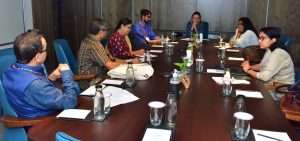 Discussion on data, evidence and responsible digital innovations
Discussion on data, evidence and responsible digital innovations
Lack of a strong privacy policy in the digital apps developed was also identified as a major hindrance to going forward in an increasingly digital era. It is exacerbated by the fact that most of the apps have privacy policies in English rather than in the native/vernacular language spoken by the farmers. Lack of capacity to manage and analyse the big data produced in the digital ecosystem is another challenge pointed out by the participants. There is a wide gap in making use of this data that already exists, which can be seen as legacy data, to formulate further effective strategies for digital innovations.
Some of the measures to address these challenges as shared by the participants are creation of a common dashboard or interface for accessing and sharing the data with an option to question the data as well, so that need-specific data can be accessed and matters of interoperability can also be solved. There is a need to set up a convergence platform because ultimately various stakeholders with similar service models reach farmers with the same queries, but for different platforms, challenging the availability of systematic and organized data. Ethical practices should be adhered to, such as agreements between the various stakeholders including farmers, while sharing the data so as to build trust between stakeholders as well as for data security.
Participants believe that government institutions are still hesitant to share data. If the data is opened up for analysis, more customized and relevant digital services can be delivered. Some of the strategies to solve challenges related to data privacy, as discussed, are storing data in password protected websites, coding of primary data, masking data partially, having data privacy policy and user level agreements (ULA), accessing and storing data through sensors. Engaging third party evaluators (external agency, research institutes) to assess data quality and impact of the project is another strategy that is being already practiced by some stakeholders.
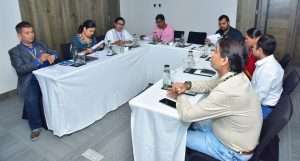 Discussion on data, evidence and responsible digital innovations
Discussion on data, evidence and responsible digital innovations
Strategic Partnerships and Capacity Needs Assessment to Promote Gender Digital Inclusion
In this session, aspects related to current patterns of collaboration in digital service delivery, the types of partnerships that are needed for promoting digitally inclusive innovation and the existing capacity needs and gaps to enable gender-responsive and inclusive digital innovations were discussed. All the participants acknowledged that partnerships with multiple stakeholders are crucial for providing innovative digital solutions. There is general agreement that most of the digital initiatives are project based, and therefore further scaling up calls for much support from government, especially for a strong partnership. This was further validated by quoting the success of Jeevika Project from Bihar. Partnerships are done mainly for knowledge sharing (research organizations), technical capacity building (private sector, NGOs), data collection (NGOs), service delivery (NGOs, private sector, government organizations), feedback and impact assessment (NGOs, private sector, research organizations), evidence building (research organizations), handholding/service expansion (government sector). Other interesting aspects discussed were the need for partnerships to have a shared vision, flexible/adaptive framework, strong governance as well as facilitators, such as innovation brokers, so that it is sustainable, scalable and cross learning can take place. Actor landscape mapping is another measure that can expedite partnerships as advocated by some other stakeholders.
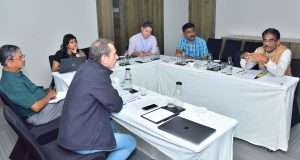 Discussion on strategic partnerships to promote gender digital inclusion
Discussion on strategic partnerships to promote gender digital inclusion
The main points to address the capacity gaps and enable gender-responsive digital innovations are discussed now. Gender is mostly an afterthought in most initiatives. Internalizing the concept of gender and harmonising efforts while focussing on the gender dimension is crucial but, it is also a challenge as observed by the stakeholders. There is still a lack of awareness on why gender matters in agriculture and agricultural projects. Hence, there is a need to sensitise multiple stakeholders (individuals and also at the organisational level) on bringing gender inclusion within the ambits of the digital projects and programmes they are involved with. To start with, digital initiatives should have a clear intention to be gender inclusive and have identified action points/nodes for acting on it. To enable this whole process there must be a continuous effort on capacity development at all levels through a gender lens. Generally, digital tools do not have a women centric design, and for this, trans-disciplinary partnerships need to be nurtured in the developmental phase. The importance of having a gender focal point wherein gender inclusiveness is ensured and incentivized was also discussed. Some of the stakeholders shared good practices, such as identifying gender champions in a group who will act as influencers and ensure gender inclusiveness. Another good practice championed was to include women and other marginalised groups while pilot testing digital innovations so as to ensure a gender inclusive design and promote gender conscious scaling. Some also felt that collecting evidence from gender inclusive practices and sharing it with stakeholders could also be one of the strategies for promoting gender inclusion across a wider expanse of stakeholders.
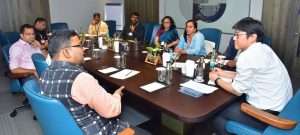 Discussion on capacity needs assessment to promote gender digital inclusion
Discussion on capacity needs assessment to promote gender digital inclusion
MY LEARNINGS
The workshop was timely as it dwelt on a topic that is relevant in the era of digital agriculture and transformation of food systems to attain SDGs, apart from being well-planned and executed. The sessions were engaging, and in each session various aspects of digital innovations and transformations were comprehensively discussed. The workshop facilitated sharing of knowledge and expertise among diverse participants (through break-out groups) who are involved in research, development, management and implementation of food-water-land systems based digital application programmes and policies.
On a personal note, it was a great learning opportunity for me and the knowledge I gained is summarised below.
The digital ecosystem is vast, encompassing multiple stakeholders, delivering a wide range of services through innumerable touch points. From college students to big tech companies all are creating digital technologies practically. Thus, the problem is of plenty rather than of scarcity. The key to enter into the digital ecosystem for any intervention is its mapping. The potential of big data or legacy data to formulate more context specific and farmer relevant solutions is high, but to create value in this data there is need for capacity, which is widely lacking. Hence capacity development at different levels (individual, organizational, etc.) should be carried out continuously.
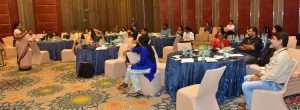 Dr. Ranjitha Puskur (IRRI) summarising the reflections from the workshop
Dr. Ranjitha Puskur (IRRI) summarising the reflections from the workshop
Infrastructure is ever evolving, but there is a need to integrate it for better usability along with need-specific service delivery. Multiple platforms serving the same needs, operating in similar domains exist sporadically in the digital ecosystem, so convergence can immensely add value to the service. Though there is the issue of data quality and accessibility, the availability of big data is an opportunity as well as a challenge. A challenge that can be tackled with enhanced capacity, so as to tap into the potential of delivering data informed digital services. Datasets are siloed across multiple platforms both in public and private domains. It is crucial to unlock this data so as to make visible the regional and sub-regional level datasets for devising more customized, relevant and useful data informed services to farmers. Context-specific solutions are needed to bridge the gap between demand and supply of digital solutions. A human centric design is the need of the hour rather than focusing solely on state-of-the-art tools and scientific rigor. Content that is inclusive also needs to cater to the needs of small and marginal farming households, and more so to the women and youth involved in farming. Platforms need to be created to cater to multiple actors in the value chain who might pay for some of these services, such as traders, buyers, information brokers, producer organisations, service providers, etc.
Strategic partnerships between multiple stakeholders are important for nurturing the digital ecosystem. Focus on the gender inclusivity of digital innovations are yet to be strengthened, and partner sensitization, developing capacity for need assessment and gender scaling are major measures that need to be emphasised.
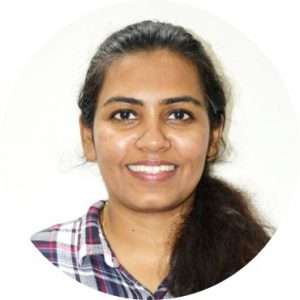 Ditty Maria Dominic is working as Research Fellow at Centre for Research on Innovation and Science Policy (CRISP), Hyderabad, Telangana, India. She can be reached at Email: ditty794@gmail.com
Ditty Maria Dominic is working as Research Fellow at Centre for Research on Innovation and Science Policy (CRISP), Hyderabad, Telangana, India. She can be reached at Email: ditty794@gmail.com

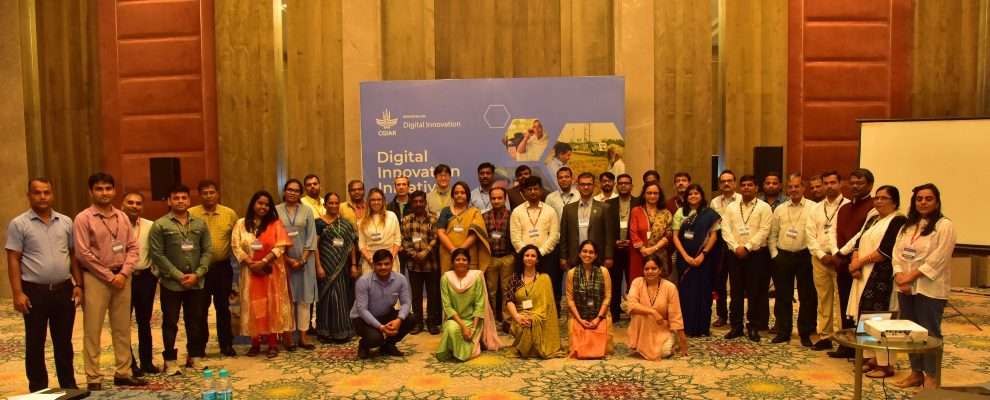

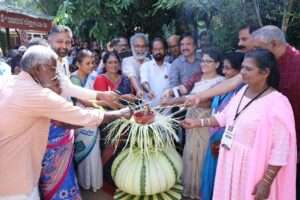

Add Comment